HC Matcon Inc. (HCM) core values are Teamwork, Innovation, Service, and Sustainability. These values are reflected in the way that HCM operates. We seek to derive innovative solutions by engaging the broad experience base of our team and associates. Sustainability to HCM means building in a way that minimizes the burden of today’s development on resources, such that the ability of future generations to survive with a similar quality of life remains intact.
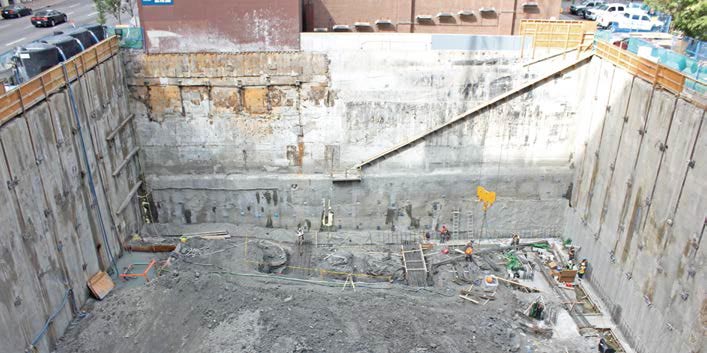
21.3 ft (6.5 m) deep shotcrete underpinning below an existing building footing on the west elevation at The Vogue, Calgary, AB, Canada
Sustainable development requires thoughtful decisions to be made at all levels of project planning and execution, including conceptual design, site selection, design parameter identification, detailed design, material specification, construction, and ultimately asset management. Clearly, alignment of project team goals and objectives is required to move toward truly sustainable development. One of the difficulties associated with multi-trade construction is that achievement of this alignment can sometimes be difficult. HCM does not allow this difficulty to impede efforts toward sustainability.
HCM and its partner engineering firm RWH Engineering Inc. (RWH) have developed a simple method of evaluating the relative environmental footprint of different project design and execution choices using a web-based tool named SEDA (Sustainable Engineering Design Audit). The tool permits comparative evaluation of design options by assigning a score based on the environmental impact of the materials required for each design. The design with the lowest score uses resources most efficiently.
SEDA receives material and fuel quantity inputs based on estimating outputs. Using the Econvent life-cycle database (version 2), materials are assessed for impact in nine fields (planetary boundaries), including climate change, biodiversity loss, biogeochemical, ocean acidification, land use, fresh water, ozone depletion, atmospheric aerosols, and chemical pollution.

41 ft (12.5 m) deep shotcrete underpinning below the bottom of an existing building footing on the east elevation
HCM has observed that the result of completing a SEDA score analysis is greater than a simply establishment of relative footprints. The process requires collaboration between the design, construction, and ownership teams. This collaboration that may otherwise not occur is the type of effort that is required to achieve sustainable development.
Based on SEDA score analysis, HCM has found that shotcrete is a sustainable choice in many applications. The following presents a few examples of HCM’s recent experience applying shotcrete toward sustainability following the completion of a SEDA score analysis.
Deep Shotcrete Underpinning
RWH designed a 57 ft (17.5 m) deep shoring system for the new Vogue building in downtown Calgary, AB, Canada. The project was constrained by existing buildings on the east and west property lines—21 and 12 stories, respectively.
RWH evaluated two designs for the shoring system for this project: a conventional 35 in. (880 mm) diameter drilled caisson wall versus a 6 in. (150 mm) thick tied-back shotcrete shoring system. Both systems were designed to allow for the excavation to extend 41.3 ft (12.6 m) below the existing building footing.
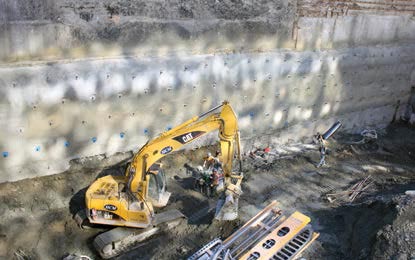
Tied back shotcrete underpinning at The Vogue
The shotcrete shoring system offered savings of 525 yd3 (400 m3) of concrete and 24,200 lb (11,000 kg) of steel over the caisson wall. Additionally, the shotcrete was set back to the footings of the buildings on both the east and west sides so that the face of the shoring was flush with the property line. This method saved 16 in. (400 mm) of shoring thickness that would have been required for a traditional caisson wall, allowing the owner to maximize usable below-grade parking area.
The SEDA score of this project was 1.0 for shotcrete (best of options evaluated) and 1.23 for the caisson wall. A score of 1.23 indicates that the caisson wall had an estimated 23% greater environmental footprint based on material use.
Heritage Garden Landscape Walls
HCM was contracted for the structural design and installation of a reinforced concrete, water retaining, undulating pool structure for the Rock Garden at Royal Botanical Gardens in Hamilton, ON, Canada. The pool restoration was part of a total renovation of the 80-year-old garden that included repairing deteriorated features and introducing new elements. Repairs and new elements were designed to respect the heritage nature of the garden.
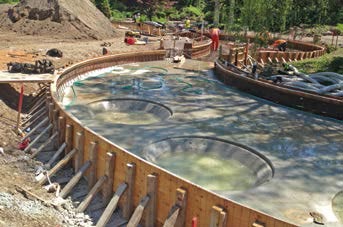
Single-sided formwork at Royal Botanical Gardens Rock Garden pool, Hamilton, ON, Canada
 David Ruhl, P.Eng., is Contracts Manager with HCM Shotcrete. He has 7 years of consulting and construction experience with a focus in concrete construction, concrete technology, corrosion control, structural restoration, and concrete coatings.
David Ruhl, P.Eng., is Contracts Manager with HCM Shotcrete. He has 7 years of consulting and construction experience with a focus in concrete construction, concrete technology, corrosion control, structural restoration, and concrete coatings.
HCM worked with RWH to provide a design build solution for the rock garden pool to meet the needs of the architect and general contractor, including providing waterproofing solutions for submerged conditions. Due to the unique geometry of the pool structure, HCM proposed the use of shotcrete placement methods for concrete pool walls. The proposal was based on a SEDA score analysis of formed concrete and shotcrete placement methods for the wall elements. Because of the unique geometry, custom (non-reusable) formwork was required for walls. Shotcrete allowed for elimination of 50% of the formwork—a reduction of 2000 ft2 (185.8 m2) of formwork over the conventionally formed option. Additionally, the shotcrete surface was finished by hand to mimic aged concrete to maintain the heritage aesthetic of the pool feature.
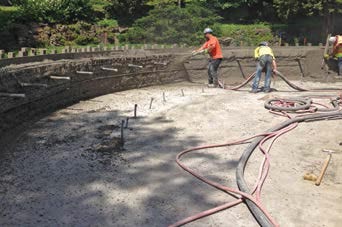
Shotcrete placement at Royal Botanical Gardens Rock Garden pool
The SEDA score of this project was 1.0 for shotcrete (best of options evaluated) and 1.13 for conventional formwork. A score of 1.13 indicates that the conventionally formed wall had an estimated 13% greater environmental footprint.
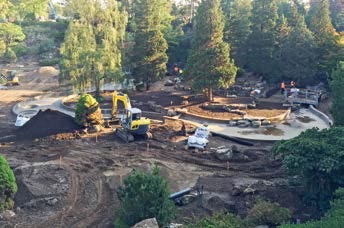
Wide angle, showing half of pool extent
These projects exemplify opportunities to minimize the environmental impact of a facet of the construction of large projects through the application of shotcrete. HCM continues to look for opportunities to take steps toward sustainable development with a hope that an increasing number of project facets are reviewed, optimized, and chosen with sustainability in mind.
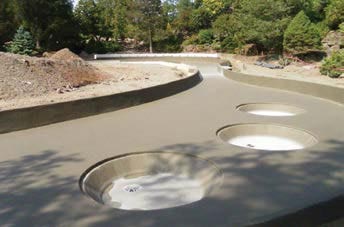
Pour five of Royal Botanical Gardens Rock Garden pool
